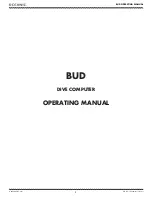
6
Service & Maintenance
33
Series 903 Cold Cathode Vacuum Sensor
Instruction Manual - #109030026
6.5.2 Cleaning
If cleaning ultrasonically, use high quality detergents compatible with aluminum, such as
ALCONOX®
Scrubbing with mild abrasives can remove most contamination. Scotch- Brite
TM
or a fine emery
cloth may be effective. Rinse with alcohol to remove particulates.
Clean aluminum and ceramic parts chemically in a wash, such as a 5 to 20% sodium hydroxide
solution (not for semiconductor processing), at room temperature (200C) for one minute. Follow
with a preliminary rinse of deionized water. Remove the black residue left on aluminum parts due
to this process in a 50 to 70% nitric acid dip for about 5 minutes.
NOTE: Chemical cleaning should not be used to clean the anode; mild abrasives or
ultrasonic cleaning are acceptable.
Each of the above cleaning methods should be followed with multiple rinses of deionized water.
Dry all internal components and the sensor body 8 in a clean oven. The two ceramic spacers 2 and
5) are slightly porous and will require longer drying time.
6.5.3 Assembly
Wear gloves and assemble with clean tools.
Check the anode (9). It should be straight and centered with the sensor body Leaf spring in contact
with cathode (8) for proper operation. Roll the sensor body on a flat surface and look for any radial
run out motion.
1.
Install the ground shield (6) using tweezers. Make sure that, at the groove of its larger diameter,
the ground shield interlocks with the locating collar (12).
2.
Slide the small ceramic spacer (5) over the small end of the ground shield (6). Check that the
leaf spring (10) will contact the base of the cathode as shown to the right. If not, remove the
small ceramic spacer and the ground shield, and gently bend the leaf spring towards the anode
(9) and then replace the ground shield and ceramic spacer.
3.
Slide the cathode (4), the grid washer (3), and the large ceramic spacer (2) into place. The grid
washer has a concave shape. Refer to the figure to see its installation orientation.
4.
Insert the small end of the compression spring (1) into the sensor body (8). Using your thumbs,
push the larger end of the spring into the sensor body until it is contained within the tube.
Using the smooth-jaw, needle-nose pliers, work the compression spring down into the sensor
body until it is fully seated in the formed groove.
5.
Inspect the ground shield (6) and the grid washer (3) to verify they are centered with respect to
the anode (9). If adjustment is needed, gently reposition the grid washer/cathode assembly,
taking care not to scratch the grid washer.
6.
Measure the resistance between the ion current feed through pin (14) and the grid washer (3)
to verify that the leaf spring (10) is in contact with the cathode (4). The measurement should
indicate a short circuit between them. There should be an open circuit between the ion current
feed through pin (14) and both the high voltage feed through pin (11) and sensor body (8).
The Sensor is ready for re-installation on the vacuum system. If it is not immediately installed, cover
the flange with clean, vacuum-grade cap and flange protector.
Содержание 109030111
Страница 2: ......
Страница 6: ...6 Series 903 Cold Cathode Vacuum Sensor Instruction Manual 10903002...
Страница 18: ...3 Specifications 18 Series 903 Cold Cathode Vacuum Sensor Instruction Manual 109030026 Notes...
Страница 36: ...6 Service Maintenance 36 Series 903 Cold Cathode Vacuum Sensor Instruction Manual 109030026 Notes...
Страница 38: ...Series 903 Cold Cathode Vacuum Sensor Instruction Manual 109030026...
Страница 39: ......








































